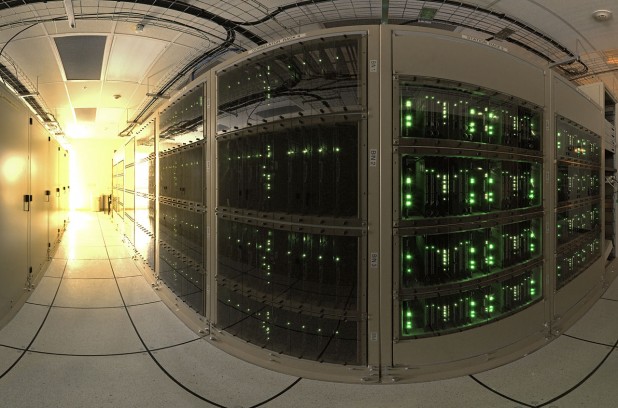 The correlator in the ALMA Array Operations Site Technical Building.[/caption] Building and operating a supercomputer at more than three miles above sea level poses some unique problems, the designers of the recently installed Atacama Large Millimeter/submillimeter Array (ALMA) Correlator discovered. Why build a supercomputer at 16,000 feet? Because the ALMA computer serves as the brains behind the ALMA astronomical telescope, a partnership between Europe, North American, and South American agencies. It’s the largest such project in existence. Based high in the Andes mountains in northern Chile, the telescope includes an array of 66 dish-shaped antennas in two groups. The telescope correlator’s 134 million processors continually combine and compare faint celestial signals received by the antennas in the ALMA array, which are separated by up to 16 kilometers, enabling the antennas to work together as a single, enormous telescope, according to Space Daily. Funded by the US National Science Foundation (NSF), and designed, constructed, and installed primarily by the National Radio Astronomy Observatory (NRAO), the back-end correlator is tuned for signal processing. The four “quadrants” of the correlator can each process data coming from 504 antenna pairs. ALMA’s Website reports that signals are processed via tunable filter bank cards, four of which are needed per antenna. Each tuner card can “slice and dice” the perceived spectrum that the antennas “see,” allowing them to make specialized observations. (Fifty radio antennas make up the main ALMA array; an additional array of 16 antennas, called the Atacama Compact Array (ACA), is provided by the National Astronomical Observatory of Japan (NAOJ) and has its own Fujitsu-designed correlator; there’s a 2010 paper describing that design.) All told, the supercomputer includes 134 million processors and performs up to 17 quadrillion operations per second, according to Space Daily. That would put it close to the top of the semiannual TOP500 supercomputer list, which ranks the world’s most powerful supercomputers; since ALMA Correlator is a special-purpose machine, however, it won’t qualify.
The correlator in the ALMA Array Operations Site Technical Building.[/caption] Building and operating a supercomputer at more than three miles above sea level poses some unique problems, the designers of the recently installed Atacama Large Millimeter/submillimeter Array (ALMA) Correlator discovered. Why build a supercomputer at 16,000 feet? Because the ALMA computer serves as the brains behind the ALMA astronomical telescope, a partnership between Europe, North American, and South American agencies. It’s the largest such project in existence. Based high in the Andes mountains in northern Chile, the telescope includes an array of 66 dish-shaped antennas in two groups. The telescope correlator’s 134 million processors continually combine and compare faint celestial signals received by the antennas in the ALMA array, which are separated by up to 16 kilometers, enabling the antennas to work together as a single, enormous telescope, according to Space Daily. Funded by the US National Science Foundation (NSF), and designed, constructed, and installed primarily by the National Radio Astronomy Observatory (NRAO), the back-end correlator is tuned for signal processing. The four “quadrants” of the correlator can each process data coming from 504 antenna pairs. ALMA’s Website reports that signals are processed via tunable filter bank cards, four of which are needed per antenna. Each tuner card can “slice and dice” the perceived spectrum that the antennas “see,” allowing them to make specialized observations. (Fifty radio antennas make up the main ALMA array; an additional array of 16 antennas, called the Atacama Compact Array (ACA), is provided by the National Astronomical Observatory of Japan (NAOJ) and has its own Fujitsu-designed correlator; there’s a 2010 paper describing that design.) All told, the supercomputer includes 134 million processors and performs up to 17 quadrillion operations per second, according to Space Daily. That would put it close to the top of the semiannual TOP500 supercomputer list, which ranks the world’s most powerful supercomputers; since ALMA Correlator is a special-purpose machine, however, it won’t qualify.
Three-Mile-High Supercomputer Poses Unique Challenges
[caption id="attachment_6930" align="aligncenter" width="618"]  The correlator in the ALMA Array Operations Site Technical Building.[/caption] Building and operating a supercomputer at more than three miles above sea level poses some unique problems, the designers of the recently installed Atacama Large Millimeter/submillimeter Array (ALMA) Correlator discovered. Why build a supercomputer at 16,000 feet? Because the ALMA computer serves as the brains behind the ALMA astronomical telescope, a partnership between Europe, North American, and South American agencies. It’s the largest such project in existence. Based high in the Andes mountains in northern Chile, the telescope includes an array of 66 dish-shaped antennas in two groups. The telescope correlator’s 134 million processors continually combine and compare faint celestial signals received by the antennas in the ALMA array, which are separated by up to 16 kilometers, enabling the antennas to work together as a single, enormous telescope, according to Space Daily. Funded by the US National Science Foundation (NSF), and designed, constructed, and installed primarily by the National Radio Astronomy Observatory (NRAO), the back-end correlator is tuned for signal processing. The four “quadrants” of the correlator can each process data coming from 504 antenna pairs. ALMA’s Website reports that signals are processed via tunable filter bank cards, four of which are needed per antenna. Each tuner card can “slice and dice” the perceived spectrum that the antennas “see,” allowing them to make specialized observations. (Fifty radio antennas make up the main ALMA array; an additional array of 16 antennas, called the Atacama Compact Array (ACA), is provided by the National Astronomical Observatory of Japan (NAOJ) and has its own Fujitsu-designed correlator; there’s a 2010 paper describing that design.) All told, the supercomputer includes 134 million processors and performs up to 17 quadrillion operations per second, according to Space Daily. That would put it close to the top of the semiannual TOP500 supercomputer list, which ranks the world’s most powerful supercomputers; since ALMA Correlator is a special-purpose machine, however, it won’t qualify.
The correlator in the ALMA Array Operations Site Technical Building.[/caption] Building and operating a supercomputer at more than three miles above sea level poses some unique problems, the designers of the recently installed Atacama Large Millimeter/submillimeter Array (ALMA) Correlator discovered. Why build a supercomputer at 16,000 feet? Because the ALMA computer serves as the brains behind the ALMA astronomical telescope, a partnership between Europe, North American, and South American agencies. It’s the largest such project in existence. Based high in the Andes mountains in northern Chile, the telescope includes an array of 66 dish-shaped antennas in two groups. The telescope correlator’s 134 million processors continually combine and compare faint celestial signals received by the antennas in the ALMA array, which are separated by up to 16 kilometers, enabling the antennas to work together as a single, enormous telescope, according to Space Daily. Funded by the US National Science Foundation (NSF), and designed, constructed, and installed primarily by the National Radio Astronomy Observatory (NRAO), the back-end correlator is tuned for signal processing. The four “quadrants” of the correlator can each process data coming from 504 antenna pairs. ALMA’s Website reports that signals are processed via tunable filter bank cards, four of which are needed per antenna. Each tuner card can “slice and dice” the perceived spectrum that the antennas “see,” allowing them to make specialized observations. (Fifty radio antennas make up the main ALMA array; an additional array of 16 antennas, called the Atacama Compact Array (ACA), is provided by the National Astronomical Observatory of Japan (NAOJ) and has its own Fujitsu-designed correlator; there’s a 2010 paper describing that design.) All told, the supercomputer includes 134 million processors and performs up to 17 quadrillion operations per second, according to Space Daily. That would put it close to the top of the semiannual TOP500 supercomputer list, which ranks the world’s most powerful supercomputers; since ALMA Correlator is a special-purpose machine, however, it won’t qualify.
 The correlator in the ALMA Array Operations Site Technical Building.[/caption] Building and operating a supercomputer at more than three miles above sea level poses some unique problems, the designers of the recently installed Atacama Large Millimeter/submillimeter Array (ALMA) Correlator discovered. Why build a supercomputer at 16,000 feet? Because the ALMA computer serves as the brains behind the ALMA astronomical telescope, a partnership between Europe, North American, and South American agencies. It’s the largest such project in existence. Based high in the Andes mountains in northern Chile, the telescope includes an array of 66 dish-shaped antennas in two groups. The telescope correlator’s 134 million processors continually combine and compare faint celestial signals received by the antennas in the ALMA array, which are separated by up to 16 kilometers, enabling the antennas to work together as a single, enormous telescope, according to Space Daily. Funded by the US National Science Foundation (NSF), and designed, constructed, and installed primarily by the National Radio Astronomy Observatory (NRAO), the back-end correlator is tuned for signal processing. The four “quadrants” of the correlator can each process data coming from 504 antenna pairs. ALMA’s Website reports that signals are processed via tunable filter bank cards, four of which are needed per antenna. Each tuner card can “slice and dice” the perceived spectrum that the antennas “see,” allowing them to make specialized observations. (Fifty radio antennas make up the main ALMA array; an additional array of 16 antennas, called the Atacama Compact Array (ACA), is provided by the National Astronomical Observatory of Japan (NAOJ) and has its own Fujitsu-designed correlator; there’s a 2010 paper describing that design.) All told, the supercomputer includes 134 million processors and performs up to 17 quadrillion operations per second, according to Space Daily. That would put it close to the top of the semiannual TOP500 supercomputer list, which ranks the world’s most powerful supercomputers; since ALMA Correlator is a special-purpose machine, however, it won’t qualify.
The correlator in the ALMA Array Operations Site Technical Building.[/caption] Building and operating a supercomputer at more than three miles above sea level poses some unique problems, the designers of the recently installed Atacama Large Millimeter/submillimeter Array (ALMA) Correlator discovered. Why build a supercomputer at 16,000 feet? Because the ALMA computer serves as the brains behind the ALMA astronomical telescope, a partnership between Europe, North American, and South American agencies. It’s the largest such project in existence. Based high in the Andes mountains in northern Chile, the telescope includes an array of 66 dish-shaped antennas in two groups. The telescope correlator’s 134 million processors continually combine and compare faint celestial signals received by the antennas in the ALMA array, which are separated by up to 16 kilometers, enabling the antennas to work together as a single, enormous telescope, according to Space Daily. Funded by the US National Science Foundation (NSF), and designed, constructed, and installed primarily by the National Radio Astronomy Observatory (NRAO), the back-end correlator is tuned for signal processing. The four “quadrants” of the correlator can each process data coming from 504 antenna pairs. ALMA’s Website reports that signals are processed via tunable filter bank cards, four of which are needed per antenna. Each tuner card can “slice and dice” the perceived spectrum that the antennas “see,” allowing them to make specialized observations. (Fifty radio antennas make up the main ALMA array; an additional array of 16 antennas, called the Atacama Compact Array (ACA), is provided by the National Astronomical Observatory of Japan (NAOJ) and has its own Fujitsu-designed correlator; there’s a 2010 paper describing that design.) All told, the supercomputer includes 134 million processors and performs up to 17 quadrillion operations per second, according to Space Daily. That would put it close to the top of the semiannual TOP500 supercomputer list, which ranks the world’s most powerful supercomputers; since ALMA Correlator is a special-purpose machine, however, it won’t qualify.

